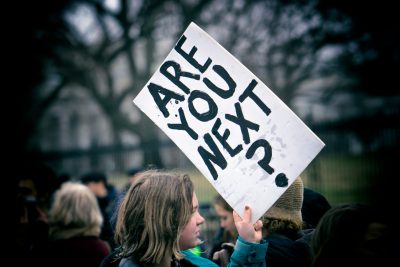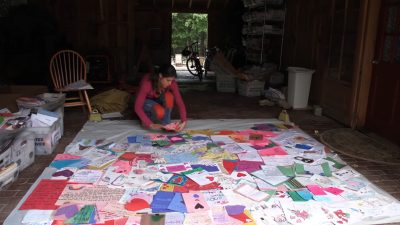Places of Refuge, Keepers of Memory
16 May 2018 – Ashley Maynor
Editor’s note: This is the final post of a series that continues the conversation begun in the February 2018 issue of The Public Historian with the roundtable “Responding Rapidly to Our Communities.”

Demonstration at the White House advocating gun laws following the school shooting at Marjory Stoneman Douglas High School in Parkland, Florida, February 2018. Photo credit: Lorie Shaull
In 2018, tragedy is visible, impossible to ignore, and happening all the time and all across the globe as History@Work’s series of posts and The Public Historian’s roundtable have so deftly illuminated.
Disasters, both natural and anthropogenic, have always been a part of contemporary history and, as such, part of our mission. But, perhaps due to the relatively new immediacy of news cycles and social media, we now live out the reports of those disasters far more quickly and viscerally in a fashion I and others have called “first-hand once removed.”
And for Americans, we have entered a new era of unprecedented gun violence and political strife. This new age is one in which we have to prepare for an active shooter in schools and public places, one where we must be vigilant around gatherings and rallies in our communities that might devolve into violence.
We are also witnessing a convergence of responses to natural and man-made disasters. Organizations whose roles have traditionally been relegated to dealing with floods and hurricanes are now offering support for these other kinds of disasters, including shootings and acts of terrorism, as they become more commonplace. For instance, the Australian Red Cross has recently published guidelines for temporary memorial management following critical incidents. And the American parochial organization, Adventist Community Services, has shifted its volunteer support, which routinely sorted water and food donations after natural disasters, to managing mail and gifts, such as those that inundated Newtown after the Sandy Hook school shooting in 2012.
The manner in which we respond to natural disaster is also moving beyond physical recovery and aid efforts and into more affective dimensions, such as the collection of artifacts and stories in the midst of crises like those evidenced Louise Shaw and Liza Dale-Hallet, who detail recent documentation efforts following an Ebola outbreak and bushfires, respectively.
As the speed of tragic news has quickened, so has the need for our institutions to hasten the pace with which we respond to the world around us. To be relevant, we must be agile. Sarah Pharaon calls upon us to rise to this challenge of nimbleness and speed in her compelling essay, “Essential Museums.” Pharaon, like many of us, is all too aware of a major side effect of having faster and greater access to information than ever before in human history: that our brave new world is one where information is highly politicized, and where any words, actions, or events can suddenly become the focus of intense media interest and scrutiny. Despite this, she beckons us to not fear the risks of diving into the murky media waters.
Callie Hawkins further cautions in “The Discourse We All Need So Seriously” that, despite the need for speed, there is no “one-size-fits-all approach to programming, especially when it comes to rapidly responding to contemporary issues” and encourages individuals to use their own expertise to tailor-fit responses to their communities. We can take as models those trailblazers in the field who have been willing to go into this uncharted territory, such as the Levine Museum (K(NO)W Justice K(NO)W Peace: The Making of a Rapid-Response Community Exhibit) and the Orange County Regional History Center (Rapid-Response Collecting after the Pulse Nightclub Massacre).
But it can feel rather daunting to know when to react, how to react, and what responses to anticipate. As the world becomes more complicated, we are left without a single checklist or set of best practices or protocols. (Though any attempts to create such tools are needed and the impossibility of a one-size-fits-all response shouldn’t keep us from trying to bring forth new resources for this area where there is a dearth of literature.)
Despite how unique each situation is and the impossibility of a silver bullet solution, I’d like to offer a roadmap or mantra of sorts for how we must proceed in our current environment when faced with disaster.
Our mission following a tragedy should be this: be places of refuge, be keepers of memory.
The simplest thing we can do when our community is in crisis is, first, to offer a space. We can offer refuges of calm and quiet, places where the community can grieve when the world around us seems loud and chaotic. The phenomenon of temporary memorials and spontaneous shrines tell us that our communities need catharsis and we can offer the places and the programming to be a part of those new grief rituals. We can open our doors, literally and figuratively.
Beyond the physical space, we are uniquely positioned to be curators and creators of a historical record as seen through the eyes of the grieving, not just the media. In a time where many news outlets are hardly unbiased or neutral, we have a great responsibility to provide an alternate and more inclusive record of how our community experienced a tragedy.

Yolie Moreno, a community activist and volunteer in Newtown, documented mail sent to the town by laying out hundreds of pieces of artwork on the floor of her barn. Still from Mayor’s documentary, “The Story of the Stuff.”
And lest you fear your outfit is too small to make an impact, consider how organizational smallness, in many cases, can become an asset: we may act with an immediacy while our larger counterparts might struggle to push through bureaucratic channels. (As one example, the Natural Disaster Photo Rescue grew out of a tiny volunteer project following the Joplin tornado in 2011.)
If we do these two things—become places of refuge and keepers of memory—then we shall remain living and relevant institutions, not, as I sometimes joke when frustrated by organizations clinging to old ways, “crusty and dusty.”
In my post to open this series of discussions, I exposed a lackluster and, ultimately, fearful and unambitious response to tragedy. While the possibility of unwanted media scrutiny or a social media backlash is a genuine concern in our day and age, impotence and inaction is, in fact, the thing we should most fear—as it is an outward sign of organizational obsolescence and irrelevance. An immediate and imperfect response is far better than one too late or none at all.
When distilled to its essence, what tragedy demands of us should, in fact, be the most natural to summon: it demands our humanity. Tragedy simply asks that we reach into the depths of our most human of hearts, find the light, and beam it back out.
~ Ashley Maynor is an award-winning filmmaker, librarian, and scholar who uses digital and analog technology to tell compelling stories. Her work in grief archives includes the interactive web documentary, The Story of the Stuff; a module for LIS students, Issues in Temporary Memorial Preservation; and the book chapter “Response to the Unthinkable: Collecting and Archiving Condolence and Temporary Memorial Materials following Public Tragedies” in the Handbook of Research on Disaster Management and Contingency Planning in Modern Libraries.



